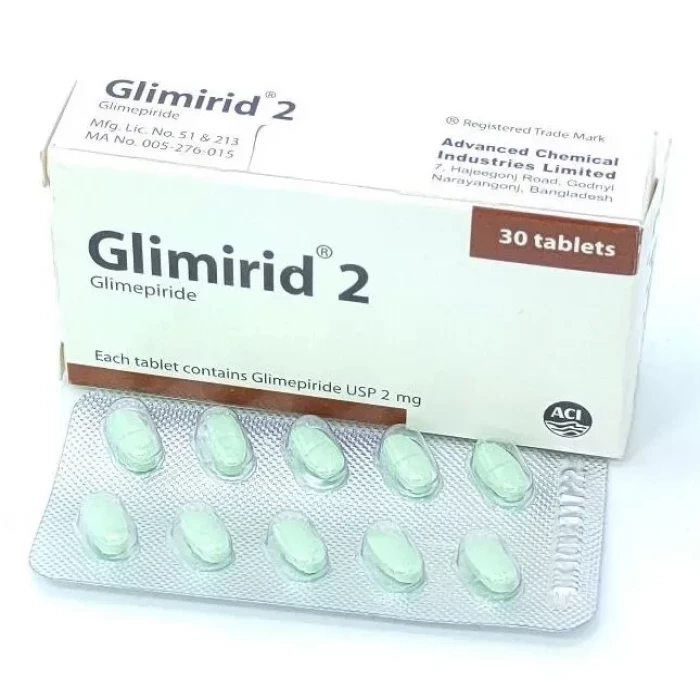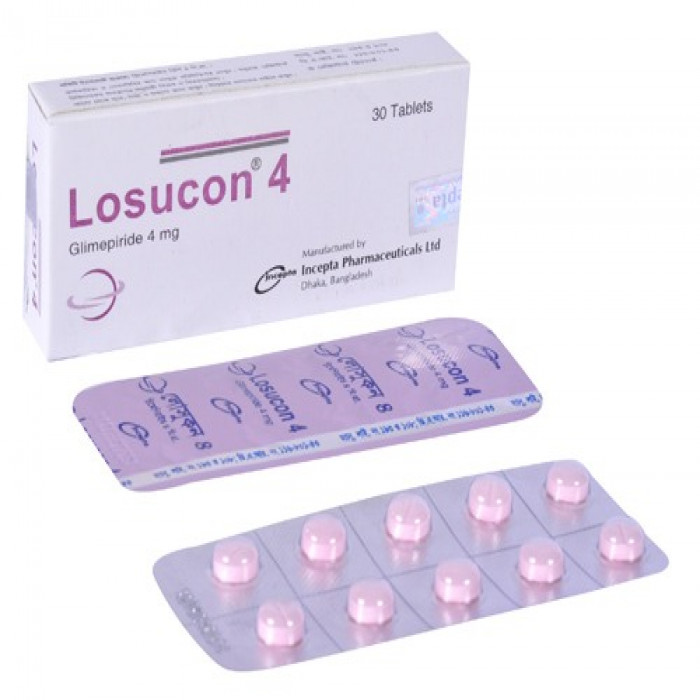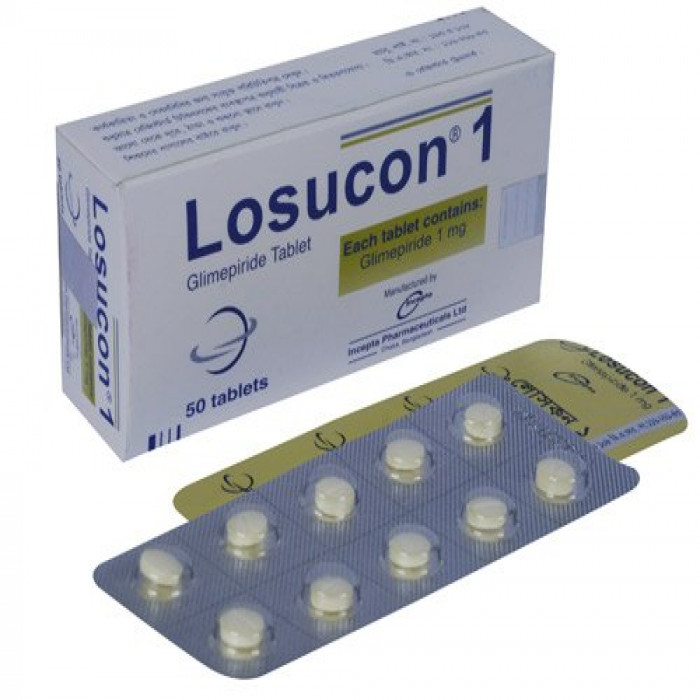
✔ 100% Authentic Product
👁️ Currently Viewing 1456
Glimepiride, the active ingredient in Glimirid, belongs to the sulfonylurea class of antidiabetic medications. It works primarily by stimulating the release of insulin from the functioning beta cells of the pancreas. Glimepiride also enhances the sensitivity of beta cells to glucose, improving insulin secretion in response to normal physiological glucose levels. Additionally, Glimepiride has extrapancreatic effects, such as reducing basal glucose production in the liver and increasing peripheral tissue sensitivity to insulin, which further helps in lowering blood sugar levels. The hypoglycemic effect of a single dose can last up to 24 hours in non-fasting diabetic patients.
Discount
Price: ৳ 113
MRP:
৳
120
6%
Off

100% Genuine Products, Guaranteed

Safe & Secure Payments, Always

Fast, Secure & Efficient Delivery

Proper Packaging
 Cash on Delivery - All over Bangladesh
Cash on Delivery - All over Bangladesh Regular Delivery - 12-24 Hours, Dhaka City* Charge Tk.39-59
Regular Delivery - 12-24 Hours, Dhaka City* Charge Tk.39-59 Regular Delivery - 24-48 Hours, Other Cities* Charge Tk.99-110
Regular Delivery - 24-48 Hours, Other Cities* Charge Tk.99-110
 ফ্রি ডেলিভারিঃ - ৯৯৯ টাকা+ অর্ডারে, ঢাকা
শহরে
ফ্রি ডেলিভারিঃ - ৯৯৯ টাকা+ অর্ডারে, ঢাকা
শহরে ফ্রি ডেলিভারিঃ - ২৯৯৯ টাকা+ অর্ডারে, ঢাকার
বাহিরে
ফ্রি ডেলিভারিঃ - ২৯৯৯ টাকা+ অর্ডারে, ঢাকার
বাহিরে
100% Genuine Products, Guaranteed
Safe & Secure Payments, Always
Fast, Secure & Efficient Delivery
Proper Packaging
 Cash on Delivery - All over Bangladesh
Cash on Delivery - All over Bangladesh Regular Delivery - 12-24 Hours, Dhaka City* Charge Tk.39-59
Regular Delivery - 12-24 Hours, Dhaka City* Charge Tk.39-59 Regular Delivery - 24-48 Hours, Other Cities* Charge Tk.99-110
Regular Delivery - 24-48 Hours, Other Cities* Charge Tk.99-110 ফ্রি ডেলিভারিঃ - ৯৯৯ টাকা+ অর্ডারে, ঢাকা
শহরে
ফ্রি ডেলিভারিঃ - ৯৯৯ টাকা+ অর্ডারে, ঢাকা
শহরে ফ্রি ডেলিভারিঃ - ২৯৯৯ টাকা+ অর্ডারে, ঢাকার
বাহিরে
ফ্রি ডেলিভারিঃ - ২৯৯৯ টাকা+ অর্ডারে, ঢাকার
বাহিরে
✅ Description:
Indications: Glimirid is prescribed as an additional treatment alongside diet and exercise for managing blood glucose levels in patients with Type II Diabetes Mellitus (non-insulin-dependent diabetes), where controlling hyperglycemia through diet and exercise alone is insufficient. It can be used in combination with metformin if diet, exercise, and either Glimirid or metformin alone are inadequate in controlling blood sugar. Additionally, Glimirid can be used alongside insulin therapy when blood glucose levels cannot be sufficiently controlled by diet, exercise, and an oral hypoglycemic agent. It’s important to note that combining Glimirid with insulin may increase the risk of hypoglycemia.
✔️ Side Effects:
Common side effects may include hypoglycemia, temporary visual disturbances, nausea, vomiting, diarrhea, abdominal pain, urticaria (hives), and a drop in blood pressure.
✔️ Dosage:
The dosage of Glimirid should be adjusted according to the blood glucose target for each patient. The aim is to use the lowest effective dose to achieve the desired blood sugar control. Initial and ongoing dosing should be monitored regularly by testing glucose levels in blood and urine, as this helps identify the need for adjustments and detect therapy failures.
✔️ Overdose Effects:
An overdose of Glimirid can lead to hypoglycemia. Mild symptoms should be managed with oral glucose, while severe cases, which can lead to coma or seizures, require emergency treatment with intravenous glucose and careful monitoring.
✔️ Initial Dose & Titration:
The starting dose is usually 1 mg once daily, and it can be gradually increased based on blood sugar monitoring, usually at intervals of 1 to 2 weeks. The dose progression is typically: 1 mg → 2 mg → 3 mg → 4 mg → 6 mg.
✔️ Maintenance Dose for Well-Controlled Diabetes:
In patients with stable diabetes, the typical dose is between 1 to 4 mg per day.
✔️ Dose Distribution:
Normally, Glimirid is taken as a single daily dose, which should be taken before a substantial breakfast or the first main meal of the day. Patients mustn't skip meals after taking the drug.
✔️ Switching from Other Oral Antidiabetics to Glimirid:
When transitioning from other oral blood sugar-lowering medications, Glimirid should be started at 1 mg daily. This initial dose can be increased as needed, based on the patient's response and blood glucose monitoring. However, the changeover should be done cautiously to avoid overlapping effects, which could increase the risk of hypoglycemia.
✔️ Secondary Dosage Adjustments:
As diabetes control improves and the body becomes more sensitive to insulin, the need for Glimirid may decrease, and doses should be reduced to prevent hypoglycemia. Adjustments should also be made if the patient’s weight, lifestyle, or other factors cause increased susceptibility to blood sugar fluctuations.
✔️ Administration:
Glimirid tablets should be swallowed with an adequate amount of liquid. It's important to follow a healthcare provider's recommendations for dosage adjustments and treatment regimen.
✔️ Drug Interactions:
Certain drugs can either enhance or reduce the blood sugar-lowering effects of Glimirid. Medications that may increase its hypoglycemic effects include ACE inhibitors, azapropazone, anabolic steroids, fluconazole, and several others. On the other hand, drugs like corticosteroids, calcium channel blockers, and certain diuretics may reduce Glimirid's effectiveness. Alcohol consumption, whether acute or chronic, can unpredictably alter its activity.
✔️ Contraindications:
Glimirid is not suitable for Type I Diabetes, diabetic ketoacidosis, or diabetic coma. It should not be used by individuals who are hypersensitive to Glimepiride, other sulfonylureas, or sulfonamides, nor in cases of severe liver or kidney dysfunction, or in dialysis patients.
✔️ Pregnancy & Lactation:
Glimirid should not be used during pregnancy. If pregnancy is planned, patients should transition to insulin therapy. For breastfeeding mothers, Glimirid can harm the infant, and either discontinuation of breastfeeding or a change to insulin therapy is advised.
✔️ Precautions & Warnings:
In the early weeks of treatment, there is an increased risk of hypoglycemia, which requires careful monitoring. In the event of hypoglycemia, immediate consumption of carbohydrates (glucose or sugar) can help resolve the issue.
✔️ Storage Conditions:
Store Glimirid below 30°C, away from light, and out of reach of children.
⚠️Disclaimer:
At ePharma, we’re committed to providing accurate and accessible health information. However, all content is intended for informational purposes only and should not replace medical advice from a qualified physician. Please consult your healthcare provider for personalized guidance. We aim to support, not substitute, the doctor-patient relationship.








